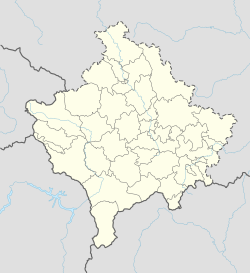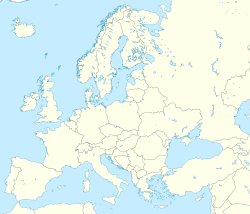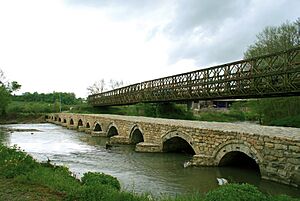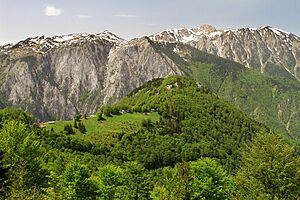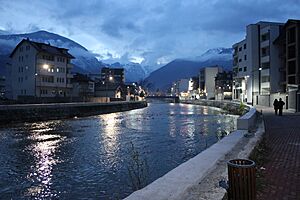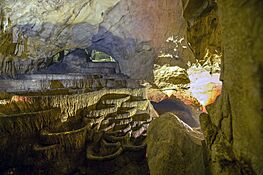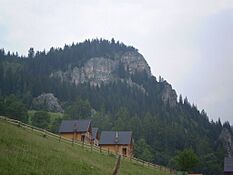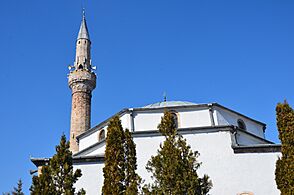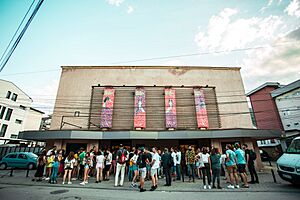Peja facts for kids
Quick facts for kids
Peja
Пећ / Peć
|
|||
|---|---|---|---|
|
City and municipality
|
|||
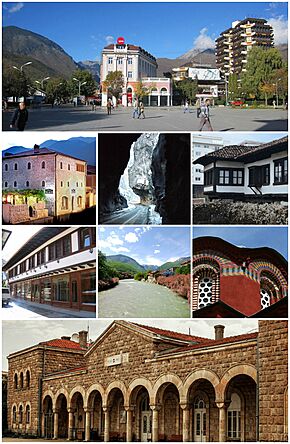
View of Peja
|
|||
|
|||
| Country | Kosovo | ||
| District | Peja | ||
| Municipality | Peja | ||
| Government | |||
| • Type | Mayor–council | ||
| Area | |||
| • Municipality | 602.63 km2 (232.68 sq mi) | ||
| Area rank | 3rd in Kosovo | ||
| Elevation | 516 m (1,693 ft) | ||
| Population
(2024)
|
|||
| • Municipality | 82,661 | ||
| • Rank | 5th in Kosovo | ||
| • Density | 137.1671/km2 (355.261/sq mi) | ||
| • Ethnicity |
|
||
| Demonym(s) | Albanian: Pejan (m), Pejane (f) | ||
| Time zone | UTC+1 (CET) | ||
| • Summer (DST) | UTC+2 (CEST) | ||
| Postal code |
30000
|
||
| Area code | +383 (0) 39 | ||
| Vehicle registration | 03 | ||
Peja (also known as Peć) is a lively city in Kosovo. It is the fourth largest city in the country. Peja is located in western Kosovo, close to the beautiful Accursed Mountains and the Lumbardhi i Pejës River. It is the main city of the Peja Municipality and the District of Peja.
In the past, Peja was ruled by different groups like the Byzantines and Bulgarians. In 1346, it became a very important religious center for the Serbian Orthodox Church. The Patriarchal Monastery of Peć is even a UNESCO World Heritage Site. Later, under Ottoman rule, the city was known as İpek. It became a busy trading center with many mosques and unique buildings. Over time, Peja has been a place where both Albanians and Serbs have strong feelings about their history and identity.
Today, the city of Peja has about 49,000 people. The whole municipality, which includes 95 villages, has around 96,450 residents. It covers an area of about 602 square kilometers (232 square miles).
Contents
What's in a Name?
The Meaning Behind Peja's Name
The city of Peja has had many names throughout history. The ancient Greek writer Ptolemy first called it Siparantum. The Serbian name, Peć, comes from the word Pećina, which means "cave". This name likely refers to the caves found near the city.
During the time of the Ottoman Empire, the city was known as İpek. In Albanian, the name is Peja (definite form) or Pejë (indefinite form). Other old names include Pescium in Latin and Episkion in Greek, meaning "Episcopal City".
Peja Through Time
Early History of Peja
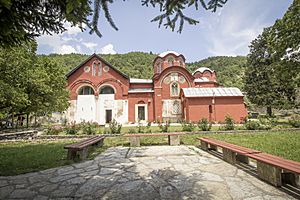
Peja is in a great spot along the Lumbardhi i Pejës river, east of the Accursed Mountains. It's thought that the medieval city was built on top of an old Roman town called Siparantum. Many ancient stone monuments called stelae have been found here, more than anywhere else in Kosovo.
In the 6th century, Slavic people settled in the Balkans. The Byzantine Empire and the First Bulgarian Empire fought for control of this area. Eventually, it came under Serbian rule. Around 1180, Serbian Prince Stefan Nemanja took control of Peja.
In 1220, Peja was given to the Žiča monastery. When that monastery was damaged, the main seat of the Serbian archbishop moved to the Patriarchal Monastery of Peć. Peja became a very important religious center in medieval Serbia. In 1346, Emperor Stefan Dušan made it the seat of the Serbian Orthodox Church. It stayed this way until 1766.
Peja Under Ottoman Rule
The Ottomans took control of Peja in 1455. They called the town İpek. It became the center of a region called the Sanjak of İpek. The first leader of this region was Mahmud Pasha Dukagjini.
During the 15th and 16th centuries, many people in the region were Orthodox Albanians. Over time, the city of Peja itself became mostly Muslim. By 1582, Ottoman records show that most households in the town were Muslim, with only a few Christian ones. A traveler in the 1660s, Evliya Celebi, described the town as being in 'Albania'.
In 1835, Albanian rebels took over the town from the Ottomans. Later, in 1899, an Albanian nationalist group called the League of Peja was formed in the city. This group wanted to protect the rights of Albanians under Ottoman rule. They also sought more freedom for Albanians within the empire. The group stopped its activities after a fight with Ottoman forces in 1900.
Peja in Modern Times
Ottoman rule ended in Peja during the First Balkan War in 1912. Montenegro took control of the city. During World War I, Austria-Hungary occupied Peja in 1916. Serbian forces later took it back in 1918. After World War I, Peja became part of Yugoslavia.
During World War II, Peja was occupied by Italian-controlled Albania. After the war, Peja became part of Yugoslavia again, as an autonomous region within Serbia.
Relations between Serbs and Albanians were often difficult in the 20th century. This tension led to the Kosovo War in 1999. During this war, Peja suffered a lot of damage. Many houses were destroyed or badly damaged. The city also saw more problems during inter-ethnic unrest in 2004.
Where is Peja?
Peja's Location and Natural Beauty
Peja is in western Kosovo, right next to the stunning Rugova Canyon. The Rugova region is a beautiful mountainous area. It became a National Park in 2013. Rugova is famous for its amazing nature and easy access to the mountains.
The city is about 85 kilometers (53 miles) west of Pristina, Kosovo's capital. It's also about 250 kilometers (155 miles) north of Tirana, Albania, and 150 kilometers (93 miles) north-west of Skopje, North Macedonia.
Water Resources in Peja
The area around Peja has lots of water. The White Drin river and the Lumbardhi i Pejës river both flow through the Peja municipality.
Peja's Climate
Peja has an Oceanic climate, which means it has mild temperatures. The average yearly temperature is about 9.0°C (48.2°F). August is usually the warmest month, with an average of 19.7°C (67.5°F). January is the coldest, with an average of -1.9°C (28.6°F).
| Climate data for Peja (1961–1990) | |||||||||||||
|---|---|---|---|---|---|---|---|---|---|---|---|---|---|
| Month | Jan | Feb | Mar | Apr | May | Jun | Jul | Aug | Sep | Oct | Nov | Dec | Year |
| Record high °C (°F) | 15.4 (59.7) |
22.6 (72.7) |
25.0 (77.0) |
28.0 (82.4) |
31.5 (88.7) |
35.8 (96.4) |
38.2 (100.8) |
35.9 (96.6) |
34.1 (93.4) |
28.3 (82.9) |
22.9 (73.2) |
18.9 (66.0) |
38.2 (100.8) |
| Mean daily maximum °C (°F) | 2.8 (37.0) |
6.0 (42.8) |
10.9 (51.6) |
16.1 (61.0) |
20.9 (69.6) |
24.1 (75.4) |
26.5 (79.7) |
26.4 (79.5) |
22.7 (72.9) |
16.9 (62.4) |
10.1 (50.2) |
4.5 (40.1) |
15.7 (60.3) |
| Daily mean °C (°F) | −0.5 (31.1) |
2.1 (35.8) |
6.4 (43.5) |
11.2 (52.2) |
15.9 (60.6) |
19.0 (66.2) |
21.1 (70.0) |
20.8 (69.4) |
17.2 (63.0) |
11.8 (53.2) |
5.9 (42.6) |
1.2 (34.2) |
11.1 (52.0) |
| Mean daily minimum °C (°F) | −3.6 (25.5) |
−1.5 (29.3) |
2.0 (35.6) |
6.1 (43.0) |
10.3 (50.5) |
13.3 (55.9) |
15.0 (59.0) |
14.8 (58.6) |
11.5 (52.7) |
6.8 (44.2) |
2.3 (36.1) |
−1.8 (28.8) |
6.3 (43.3) |
| Record low °C (°F) | −24.8 (−12.6) |
−19.3 (−2.7) |
−13.6 (7.5) |
−3.8 (25.2) |
0.6 (33.1) |
3.5 (38.3) |
6.7 (44.1) |
5.2 (41.4) |
−1.2 (29.8) |
−4.8 (23.4) |
−15.3 (4.5) |
−15.2 (4.6) |
−24.8 (−12.6) |
| Average precipitation mm (inches) | 85.9 (3.38) |
71.5 (2.81) |
65.2 (2.57) |
67.2 (2.65) |
68.2 (2.69) |
53.0 (2.09) |
54.7 (2.15) |
48.0 (1.89) |
52.1 (2.05) |
75.3 (2.96) |
118.2 (4.65) |
91.4 (3.60) |
850.7 (33.49) |
| Average precipitation days (≥ 0.1 mm) | 12.0 | 12.3 | 11.3 | 11.5 | 13.0 | 13.2 | 9.9 | 8.7 | 8.1 | 9.5 | 12.3 | 13.3 | 135.1 |
| Average snowy days | 8.1 | 6.0 | 3.7 | 0.6 | 0.0 | 0.0 | 0.0 | 0.0 | 0.0 | 0.1 | 2.0 | 6.5 | 27.0 |
| Average relative humidity (%) | 81 | 75 | 68 | 63 | 64 | 64 | 60 | 60 | 67 | 73 | 81 | 83 | 70 |
| Mean monthly sunshine hours | 69.5 | 93.3 | 143.0 | 172.0 | 207.8 | 257.7 | 274.3 | 264.9 | 206.3 | 152.6 | 86.8 | 55.3 | 1,983.5 |
| Source: Republic Hydrometeorological Service of Serbia | |||||||||||||
Fun Things to Do in Peja
Exploring Peja's Tourist Attractions
Peja is becoming a popular place for tourists. You can find information about cultural sites and maps for the Rugova Canyon at the Tourist Information Office.
If you love winter sports, there's a ski center in nearby Bogë. A really exciting adventure is the Peak of the Balkans trail. This trail goes through three countries and offers amazing mountain views. Local guides can help you explore it.
Banja of Peja is a health and tourism center in the nearby municipality of Istog. It's known for its healing waters. Peja has also added new attractions like a Zip Line and two Via Ferrata climbing routes between 2013 and 2016.
Close to Peja, you can visit the beautiful White Drin Waterfall and the Bukuroshja e Fjetur Cave. These are natural wonders in the Accursed Mountains that many tourists enjoy.
Learning and Living in Peja
Education in Peja
Education in Peja is free for all children aged 6 to 18. It includes:
- Nine years of basic school (ages 6-15).
- High school, which can be general or professional.
- Higher education at Haxhi Zeka University.
There are also optional daycare programs for younger children and a one-year "preschool". The school year runs from early September to late June. Peja is special because it's the only city in Kosovo that offers high school education in arts. There's also a school for visually impaired students.
Who Lives in Peja?
| Historical population | ||
|---|---|---|
| Year | Pop. | ±% p.a. |
| 1948 | 47,009 | — |
| 1953 | 53,548 | +2.64% |
| 1961 | 66,656 | +2.77% |
| 1971 | 90,124 | +3.06% |
| 1981 | 111,071 | +2.11% |
| 1991 | 127,796 | +1.41% |
| 2011 | 96,450 | −1.40% |
| 2024 | 82,661 | −1.18% |
| Source: Division of Kosovo | ||
In 2011, the population of Peja municipality was estimated to be 96,450 people. The city of Peja itself had about 49,000 residents.
Most people in Peja are Albanians, making up over 91% of the population. The next largest groups are Bosniaks (about 3.9%) and Egyptians (about 2.7%). There are also smaller groups of Roma, Serbs, Ashkali, and Gorani.
The table below shows the ethnic makeup of the municipality over the years:
| Year/Population | Albanians | % | Serbs | % | Montenegrins | % | Roma (Ashkali, Egyptians) | % | Bosniaks | % | Others | % | Total |
|---|---|---|---|---|---|---|---|---|---|---|---|---|---|
| 1961 Census | 41,532 | 62.35 | 8,852 | 13.28 | 12,701 | 19.05 | 728 | 1.09 | 1,397 | 2.1 | 66,656 | ||
| 1971 Census | 63,193 | 70.12 | 9,298 | 10.31 | 11,306 | 12.54 | 433 | 0.48 | 5,203 | 5.77 | 90,124 | ||
| 1981 Census | 79,965 | 71.99 | 7,995 | 7.2 | 9,796 | 8.82 | 3,844 | 3.46 | 8,739 | 7.86 | 111,071 | ||
| 1991 Census | 96,441 | 75.5 | 7,815 | 6.11 | 6,960 | 5.44 | 4,442 | 3.5 | 9,875 | 7.72 | 127,796 | ||
| January 1999 | ~104,600 | ~92 | n/a | n/a | n/a | n/a | ~3,500–4,000 | ~3.3 | n/a | n/a | ~4,000–4,200 | ~3.6 | ~113,000 |
| 2011 census | 87,975 | 91.2 | 332 | 0.4 | 3,836 | 3.9 | 3,786 | 3.9 | 521 | 0.5 | 96,450 | ||
| Source: Yugoslav Population Censuses for data through 1991, OSCE estimates for data from 1999, and 2011 census from Kosovo Republic. | |||||||||||||
Peja's Culture and Fun
Architectural Wonders in Peja
Peja's buildings show a mix of different styles, from medieval Serbian to Ottoman, Yugoslav, and modern designs. This means you can see many interesting churches, mosques, and other buildings around the city.
Some famous buildings include:
- Home of Tahir Beg: This old house from the 18th century is now the Ethnographic Museum of Peja.
- Bajrakli Mosque: An Ottoman-built mosque in the city's market area. It was rebuilt after being damaged in World War II.
- Hamam of Peja: An old Ottoman bathhouse.
- Bazaar of Peja: A historic market in the city center. It was also rebuilt after being damaged in wars.
Kinema Jusuf Gërvalla: Peja's Cinema
Peja has its own local cinema, Kinema Jusuf Gërvalla. It also works as a cultural center. It was built in 1955 and was first called 'Kino Rad' (Workers' Cinema). It was a central place for movies, discussions, music, and children's programs until 1998.
The cinema was damaged during the war but was renovated and reopened in 2001. In 2002, its name changed to ‘Kinema Jusuf Gërvalla’. For a while, it wasn't used much.
In 2016, the non-governmental organization Anibar took over the cinema. Anibar had already been holding its animation festival there since 2010. Their goal was to bring the cinema back to life. When there was a plan to privatize the building, people protested. This helped protect Kinema Jusuf Gërvalla as an important cultural site. Today, it's a busy cultural center hosting movies, music, poetry, and more.
Festivals in Peja
- Anibar International Animation Festival
Sports in Peja
Peja is a very successful city in sports! It's home to Majlinda Kelmendi, the judoka who won Kosovo's first Olympic Medal at the Rio de Janeiro Games in 2016. Her team has also won many other medals in world and European championships.
The city's main football (soccer) team is FC Besa Pejë. Its basketball team is KB Peja. Peja also has teams for handball (KH Besa Famiglia), volleyball (KV Besa), judo (Ippon), and athletics (Besa). There's even a women's basketball team, KB Penza. Since 2008, Peja has a Taekwondo Team called Tae Kwon Do Club Peja.
Peja also has an aeroclub called "Aeroklub Peja," started in 1948. This club takes part in competitions in different countries. In 2013 and 2014, it organized paragliding events, bringing paragliders from Kosovo and Albania.
Peja's Global Connections
Sister Cities of Peja
Peja is twinned with several cities around the world. This means they have special friendly relationships and often share culture and ideas.
See also
 In Spanish: Peć para niños
In Spanish: Peć para niños




